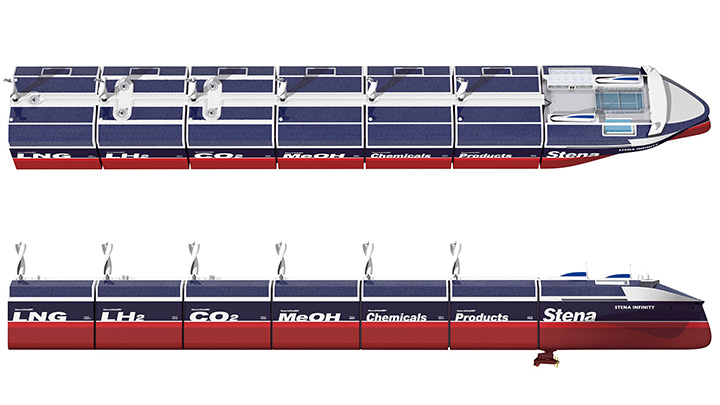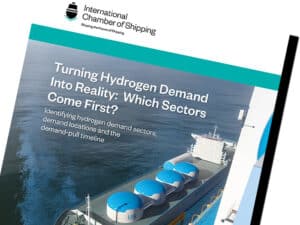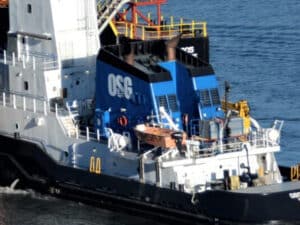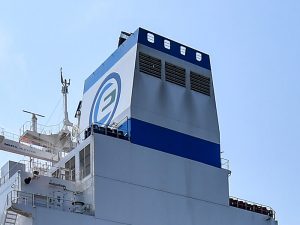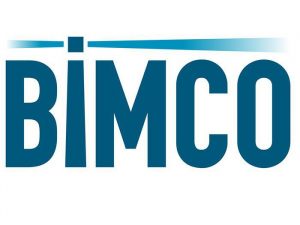
Stena Bulk concept “could be as impactful as containerization”
Written by Nick Blenkey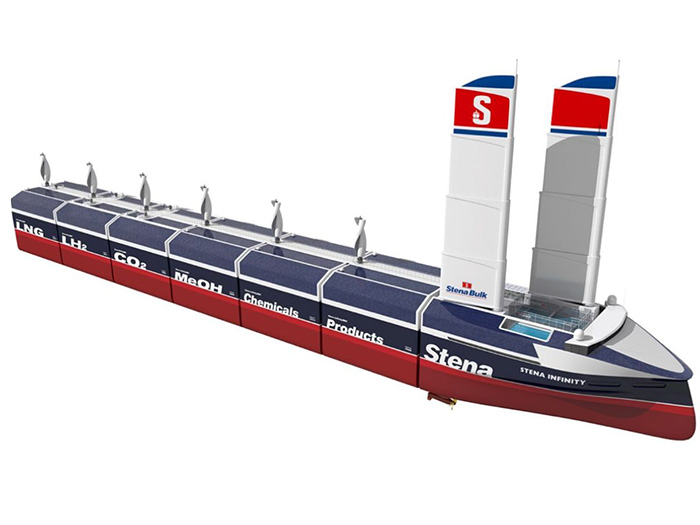
Though it’s the sails that catch the eye in this concept illustration, the key breakthrough could be its use of modular cargo units. [Image: Stena Bulk]
Able to carry both dry and wet cargoes in modular compartments, an ultra-flexible, zero emissions design unveiled by Gothenburg, Sweden, headquartered tanker operator Stena Bulk pushes many boundaries.
In an advance that could be as impactful as containerization was for intermodal freight trade, the InfinityMAX concept bulk carrier uses standardized and modular cargo units that can carry dry bulk, liquid bulk or liquified gas products (such as methane, hydrogen or ammonia), promising to significantly streamline the process of transporting wet and dry bulk cargoes.
Each of the InfinityMAX’s modular cargo units is designed to be totally self-sufficient in terms of its energy use, with wind turbines and solar panels generating all the electricity needed for internal systems. The modular units have also been designed to be able to be dropped off outside of ports and picked up by tugs, avoiding congestion and reducing call times.
HYDROGEN, WING SAILS AND SHARK SKIN
The InfinityMAX concept will use hydrogen as a marine fuel and wind turbines to generate further energy. Collapsible wing sails and a shark skin hull have also been incorporated in the concept design to significantly improve efficiency.
Although the vessels will be crewed for safety and flexibility reasons, Stena Bulk has designed the InfinityMAX concept to be semi-autonomous and meet the future demand of efficient operations without compromising safety.
InfinityMAX will also improve crew wellbeing on board, for a sustainable working environment. As a result, InfinityMAX has the potential to change the role of onboard crew, with less hard labor and more focus on monitoring and interaction with operators ashore.
“What we are proposing here is innovative, provocative and would radically reshape the way we think about bulk trade, rationalizing two segments with complimentary expertise into one shipping segment that is ready for the challenges of the future,” said Erik Hånell, President & CEO, Stena Bulk. “The application of advanced technologies—including hydrogen fuel and other efficiency measures—means that this is a vessel concept that proves our core philosophy that innovation is key to commercial success, given the challenges that we all face.
“We will continue to work closely with our innovation partners, leaving no stone unturned to ensure that the right advances happen to make the InfinityMAX concept into a reality.”
By 2050, says Stena Bulk, the growing need for transportation of energy from areas with abundant renewable supply to areas with large energy demand – carried as hydrogen, methanol, methane, and ammonia—will be a defining part of international trade.
This, combined with the requirement to transport sustainable, edible oils and chemicals, and carbon dioxide from carbon capture facilities, as well as bulk commodities, requires a vessel design that is up to the challenge of a radically reformed global economy.
With the right level of matured technologies, Stena Bulk believes that an InfinityMAX vessel could come into service between 2030 and 2035.
